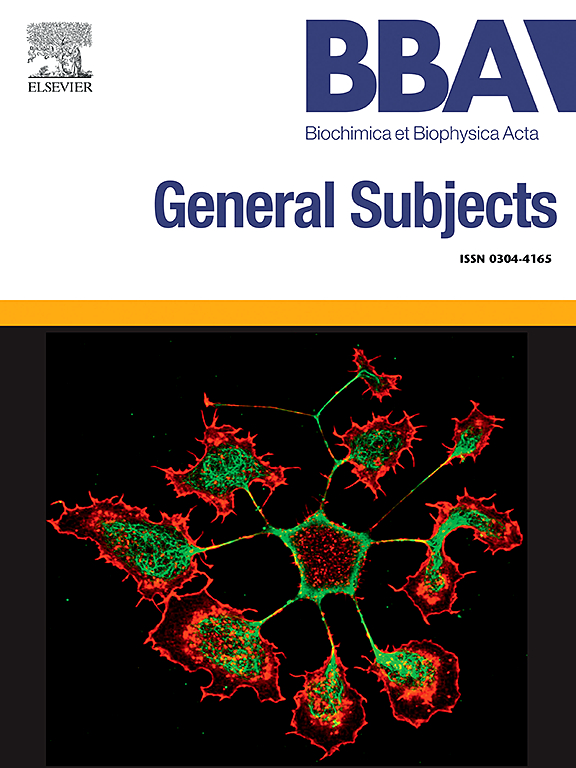细胞内K+在保护致病性二形真菌免受生物激发的抗菌肽诱导的细胞死亡中的作用。
IF 2.2
3区 生物学
Q3 BIOCHEMISTRY & MOLECULAR BIOLOGY
Biochimica et biophysica acta. General subjects
Pub Date : 2025-03-19
DOI:10.1016/j.bbagen.2025.130795
引用次数: 0
摘要
抗菌肽(AMPs)是一种很有前途的药物,尽管其抗真菌机制尚不清楚。我们基于Vu-Def1种子防御素γ-核设计了3个amp (dAMPs)。分别命名为RR、D-RR和WR,并评估其对热带念珠菌和白色念珠菌的作用。在它们的作用中,真菌细胞的K+外排引起细胞收缩。这些肽探讨了K+参与真菌死亡。我们评估了细胞收缩、氧化应激、线粒体超极化、膜透性、介质酸化、低渗条件下的抗菌活性和细胞降解。在不同时间用通道阻滞剂和K+进行活力测定。利用圆二色性和显微镜分析了dAMPs与盐和真菌细胞的相互作用。K+和Cl-通道不直接参与damps诱导的死亡。补充K+保护真菌细胞免于死亡。在测试中,阳离子通常通过电荷中和使它们失活。多肽与K+保持构象,在细胞质中发现,表明K+不中和电荷。K+不能防止氧化应激,但可以防止细胞收缩和线粒体超极化。阻尼能迅速促进介质酸化,1 min后起抑制作用,而K+能阻止酸化。膜渗透在20 min后发生,WR更快,解释了对阻滞剂缺乏保护的原因。真菌在低渗条件下加速死亡。电泳显示蛋白质降解,超微结构分析显示细胞空泡化,表明细胞质降解。因此,K+通过维持内部水平来防止细胞死亡,避免细胞降解过程的激活。本文章由计算机程序翻译,如有差异,请以英文原文为准。
A role in intracellular K+ in protecting pathogenic dimorphic fungi against induced cell death by bioinspired antimicrobial peptides
Antimicrobial peptides (AMPs) are promising drugs, though their fungal combat mechanisms remain partly unclear. We designed three AMPs (dAMPs) based on the γ-core of the Vu-Def1 seed defensin from Vigna unguiculata L. Walp. named RR, D-RR, and WR, and assessed their actions on Candida tropicalis and Candida albicans. Amidst their actions are cell shrinkage caused by K+ efflux from fungal cells. K+ involvement in fungal death by these peptides was explored. We assessed cell shrinkage, oxidative stress, mitochondria hyperpolarization, membrane permeabilization, medium acidification, antimicrobial activity under hypoosmotic conditions, and cellular degradation. Viability assays were performed with channel blockers and K+ addition at various times. The interactions of dAMPs with salts and fungal cells were analyzed using circular dichroism and microscopy. K+ and Cl− channels were not directly involved in dAMPs-induced death. Supplementation with K+ protected fungal cells from death. In tests, cations often deactivated them through charge neutralization. Peptides maintained their conformation with K+ and were found in cell cytoplasm indicating K+ did not neutralize charges. K+ did not prevent oxidative stress, but protected from cell shrinkage and mitochondria hyperpolarization. dAMPs rapidly stimulated medium acidification, followed by inhibition after 1 min, and K+ prevented acidification. Membrane permeabilization occurred after 20 min, faster with WR, explaining lack of protection from blockers. Fungal death was accelerated under hypoosmotic conditions. Electrophoresis revealed protein degradation, while ultrastructural analysis of the cells showed vacuolization, indicative of cytoplasmic degradation. Thus, K+ prevented cell death by maintaining internal levels, averting activation of cell degradation process.
求助全文
通过发布文献求助,成功后即可免费获取论文全文。
去求助
来源期刊

Biochimica et biophysica acta. General subjects
生物-生化与分子生物学
CiteScore
6.40
自引率
0.00%
发文量
139
审稿时长
30 days
期刊介绍:
BBA General Subjects accepts for submission either original, hypothesis-driven studies or reviews covering subjects in biochemistry and biophysics that are considered to have general interest for a wide audience. Manuscripts with interdisciplinary approaches are especially encouraged.
 求助内容:
求助内容: 应助结果提醒方式:
应助结果提醒方式:


